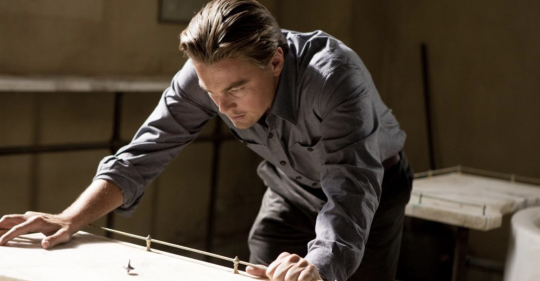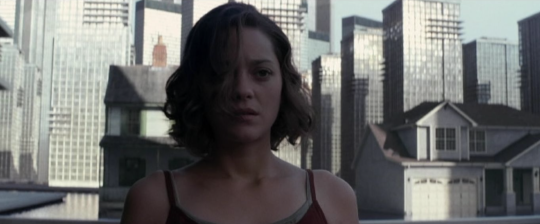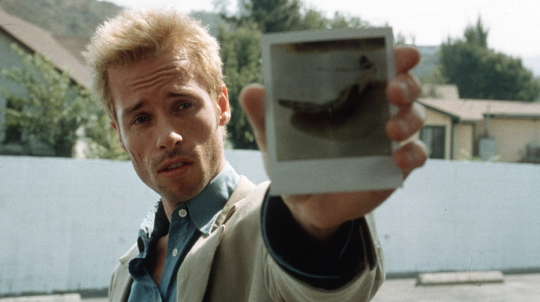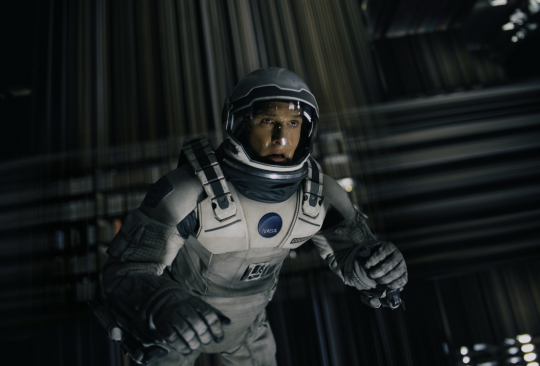Christopher Nolan: The Man Who Wasn’t There by Daniel Carlson
By Yasmina Tawil

1.
So, we’ll start with the fact that all movies are make-believe. It’s a bunch of actors on a set, wearing costumes and standing with props picked out by hordes of people you’ll never see, under the guidance of a director, saying things that have been written down for them while doing their best to say these things so that it sounds like they’re just now thinking of them. We all know this—saying it feels incredibly stupid, like pointing out that water is wet—but it’s still worth noting. There is, for example, no such person as Luke Skywalker. Never has been, never will be. He was invented by a baby boomer from Modesto. He is not real.
And we know this, and that’s part of the fun. We know that Luke Skywalker isn’t real but is being portrayed by an actor (another boomer from the Bay Area, come to think of it), and that none of the things we’re seeing are real. But we give ourselves over to the collective fiction for the greater experience of becoming involved in a story. This is one of the most amazing things that we do as humans. We know—deep down, in our bones, without-a-doubt know—that the thing we’re watching is fiction, but we enter a state of suspended reality where we imagine the story to be real, and we allow ourselves to be moved by it. We’ve been doing this since we developed language. The people telling these stories know this and bring the same level of commitment and imagination and assurance that we do as viewers, too. The storyteller knows that the story isn’t real, but for lack of a better way to get a handle on it, it feels real. So, to continue with the example, we’re excited when Luke Skywalker blows up the Death Star because he helped the good guys win. For us viewers, in this state of mutually reinforced agreement, that “happened.” It’s not real, but it’s “real”—that is, it’s real within the established boundaries of the invented world that we’ve all agreed to sit and look at for a couple of hours. Every viewer knows this, and every filmmaker acts on it, too. Except:
Christopher Nolan does not do this.
2.

There’s no one single owner or maker of any movie, and anyone who tells you different has their hand in your pocket. But there’s an argument to be made that when somebody both writes and directs the movie, it’s a bit easier to locate a sense of personhood in the final product. (This is all really rough math, too, and should not be used in court.) Christopher Nolan has directed 11 films to date, and while his style can be found in all of them, his self is more present in the ones where he had a hand in the shaping of the story—and crucially, not just that, but in the construction of the fictional world. Take away the superhero trilogy, the remake of a Norwegian thriller, the adaptation of a novel, and the historical drama, and Nolan’s directed five films that can reasonably be attributed to his own creative universe: Following (1998), Memento (2000), Inception (2010), Interstellar (2014), and Tenet (2020). These movies all involve themes that Nolan seems to enjoy working with no matter the source material, including identity, memory, and how easily reality can be called into question when two people refuse to concede that they had very different experiences of the same event. Basically, he makes movies about how perception shapes existence. How he does this, though, is unlike pretty much everybody else.
Take Inception. After a decade spent going from hotshot new talent to household name (thanks to directing the two highest-grossing Batman movies ever made, as well as the first superhero movie to earn an Oscar for acting), he had the credit line to make something big and flashy that was also weird and personal. So we got an action movie that, when first announced in the Hollywood trades, was described as being set within “the architecture of the mind.” Although this at first seemed to be a phrase that only a publicist could love, it turned out to be the best way to describe the film. This is a film, after all, about a group of elite agents who use special technology to enter someone’s subconscious dream-state and then manipulate that person’s memories and emotions. The second half of the film sees team leader Dom Cobb (Leonardo DiCaprio) and the rest of the squad actually descend through multiple nested subconsciouses to achieve their goal, even as they’re chased every step of the way by representations of Mal (Marion Cotillard), Dom’s late wife, who committed suicide after spending too much time in another’s subconscious and lost the ability to discern whether she was really alive or still in the dream-world.
I say “representations” because that’s what they are: Mal is long dead, but Dom still feels enormous guilt over his complicity in her actions, and that guilt shows up looking like Mal, whose villainous actions (the representation’s actions, that is) are just more signs of Dom not being able to come to grips with his own past. It’s his own brain making these things up and attacking itself, and it chases his entire crew down three successive layers of dream worlds. You get caught up in the movie’s world as a viewer, and you go along because Nolan is pretty good at making exciting movies that feel like theme-park rides. You accept that Dom and everybody else refer to Mal as Mal and not, say, Dom. Dom even addresses her (“her”) when her projection shows up, speaking to her as if she’s a separate being with her own will and desires and not a puppet that he’s pretending not to know he’s controlling. It’s only later that you realize that the movie is in some ways just a big-budget rendition of what it would look like to really, really want to avoid therapy.
Which is what makes Nolan different from other filmmakers:
None of this is actually happening.
Again, yes, it’s happening in the sense that we see things on screen—explosions, chases, a fight scene in a rotating hallway that’s still some of the best practical-effects work in modern action movies—but within the universe of the film, none of what’s going on is taking place in the real world. It’s all unfolding in the subconsciouses of Dom’s teammates. In the movie’s real world, they’re all asleep on a luxury jet. They’re “doing” things that have an outcome on the plot, but Nolan sets more than half the movie inside dreams. It’s a movie about reality where we spend less time in reality than in fantasy. Half the movie is pretend.
For Nolan, filmmaking is about using a dazzling array of techniques to create a visual spectacle that distracts the viewer from the fact that the real and true story is happening somewhere else: in the fringes we can’t quite see, in the things we forget to remember, or even in the realm of pure speculation.
3.

Memento arrived like (and with) a gunshot. It seemed to come out of nowhere and leave people struggling to describe it, and they usually wound up saying something like “it goes backward, but also forward at the same time, except some parts are actually really backward, like in reverse, so it’s maybe a circle?” Written by Christopher Nolan from an idea originally shared with him by his brother, Jonathan (who eventually turned it into a very different short story titled “Memento Mori”), the film follows a man named Leonard (Guy Pearce) who has anterograde amnesia and can’t form new memories, so every few minutes he sort of just resets and has to figure out where he is, what he’s doing there, and so on. He’s on the hunt for the man who attacked him and his wife, leaving his wife dead and Leonard in his present condition, which you can imagine does not make the gathering and synthesis of clues easy.
What’s more, Nolan puts the viewer in Leonard’s shoes by breaking the film’s linear timeline into two halves—call them A and B—and then alternating between them, with the added disorientation coming from the fact that one of those timeline halves plays out backward, with each successive scene showing what happened before the one you previously saw. So, if you numbered all the scenes in each timeline in chronological order, they’d look something like this when arranged in the final film: Scene A1, Scene B22, Scene A2, Scene B21, Scene A3, Scene B20, etc. You get why it messed with people’s heads.
As a result, we spend most of the movie pretty confused, just like Leonard, whose suppositions about what might or might not take place next begin to substitute for our own understanding of the film. It’s not until the end that we find out the shoe already dropped, and that Leonard killed the original attacker some time ago and has since been led on a series of goose chases by his cop friend, Teddy (Joe Pantoliano), who’s planting fake clues to get Leonard to take out other criminals. In other words, we realize that the story we thought was happening was pretend, and the real story was happening all around us, in the margins, memories, and imaginations of the characters. The most honest moment in the movie is the scene where Leonard hires a sex worker to wait several minutes in the bathroom while he gets in bed, then make a noise with the door to wake him, at which point his amnesia has kicked in again and he briefly thinks that the noise is being made by his wife. He’s wrong, of course, but this is the only time in the movie that we actually know he’s wrong. It’s the only time we truly know what’s real and what isn’t.
Yet you can’t talk about Memento without talking about Following, Nolan’s first feature. Although the film’s production was so extremely low-budget you’d think they were lying—the cast and crew all had day jobs and could only film on the weekends, so the thing took a year to make—Nolan’s willingness to dwell completely in a make-believe world that the viewer never knows about is already evident. It’s about a bored young writer who starts following strangers through the city for kicks, only for one of those strangers to catch him in the act and confront him. The stranger introduces himself as Cobb—I kindly submit here that it is not a coincidence that this is also Leonardo DiCaprio’s character’s name in Inception, but you already knew that—and reveals himself to be a burglar, spooked by the tail but willing to take on an apprentice. Cobb trains the writer to be a burglar, only for the situation to ultimately wind up implicating the writer himself in a complex blackmail plot. You see, the writer didn’t latch onto Cobb in a crowd; Cobb lured him in. The whole movie has been Cobb’s story all along, with the writer as a patsy who doesn’t understand the truth until the final frame. None of what we saw mattered, and everything that actually happened happened off-screen just before or just after we came in on a given scene. It’s like realizing the movie you’re watching turned out to be just deleted scenes from something else. You can’t say Nolan didn’t show his hand from the start.
4.

That same general concept—that the movie we’re watching is actually the knock-on effect of a movie we’ll only glimpse, or maybe never even see—underpins Nolan’s latest movies, Interstellar and Tenet, too. Interstellar has some concepts that are iffy even for Nolan (it makes total sense for someone to do something for another out of love, but somewhat less sense that that love somehow reshapes the physical universe), but it’s still a big, bold approach to exploring how time and perception shape our actions. As the film follows its core group of astronauts while they search for potentially habitable new worlds, they encounter strange visions and experiences that turn out to be their handiwork from the future reflected back at them. Sure, it raises the paradoxical question of whether they had a first mission before this that failed, so now their future selves are intervening to make the second one (which feels like the first one to the astronauts the whole time) successful, and all sorts of other stuff that your sophomore-year roommate would like to talk with you about in great detail. But so much of what we see isn’t the stuff that happens, or that winds up being important. There’s the great scene where the astronauts land on a planet near a black hole, which is wreaking havoc on how time passes on the planet. A minor disaster delays their departure for the main ship still in orbit, but when the landing team returns, they find that more than 20 years have “passed” since they left, with the one remaining team member on the ship having spent more than two decades waiting for them to return. It’s a moment of genuine horror, and it underscores the fact that what we thought was the one true reality was just the perspective of a handful of characters we happened to follow for a few minutes. There were whole things happening that changed the plot and story and direction of everything that would follow, and we never saw them; we didn’t even know we’d missed them.
Tenet is, of course, the latest and most recursive exploration yet of Nolan’s obsession with showing us a story that turns out to be mostly fake. It is almost perversely hard to even begin to explain the film (Google “Tenet timeline infographic” and have fun). One way to think about it is to imagine if the two timeline halves from Memento somehow existed at the same time, with people moving both forward and backward through time while inhabiting the same location. Basically, some scientists figured out how to “invert” the basic entropy of objects, so that they exist backward: you hold out your hand and the ball on the ground leaps up into it, because you’ve dropped it in the future, so now you can pick it up, etc. … Look, it doesn’t get easier to understand.
The upshot is, though, that we spend the film following the Protagonist (that’s his name), a CIA agent played by John David Washington, as he’s tasked with tracking down the source of the inverted stuff to figure out what’s unfolding in the future and why it’s suddenly started to make itself known in the present. He gets marginally closer to understanding the truth by the end of the film, but because this is a Nolan film that is maybe more expressly about the nature of reality than anything he’s ever done, his journey doesn’t so much take him forward as it does in a large circle. Because, and stop me if you’ve heard this, the true story of Tenet is taking place outside the Protagonist’s actions and knowledge, alongside him but invisible, often steered by people who themselves are moving “backward” through time and thus have already met the Protagonist in the future and are old friends with him by the time he meets them in his youth. Even more brain-liquefying, some of these people have been working under the orders of the Protagonist himself—the future version, that is—because his past self has already achieved the victories that allowed him to send the future people backward through time to meet his younger self so they’d achieve the victories that allow him to etc., etc., etc.
With Tenet, Nolan didn’t just make a movie that challenged perception, like Memento, or that dwelt in fiction, like Inception. He made a movie that can only be understood (to whatever degree true understanding is possible) by rewatching the movie itself, over and over, as the multiple timelines and harrowingly complex bits of cause and effect come into some kind of focus. The whole movie itself isn’t happening, in a sense, but is just the ramifications of something else, the echoes of a shout whose origin we’re straining to pinpoint. It both is and isn’t.
5.

Christopher Nolan is a talented director of action-driven suspense thrillers. He’s canny at controlling the audience’s emotions, and he knows how to put on a dazzling show. Plus he’s fantastic at picking when to deploy non-computer-generated effects for maximum impact. But you could say that about a lot of other directors, too. What sets Nolan apart from the rest, and what makes him a director to keep watching and returning to, is the teasing way his movies wind up being just deceptive enough to fool you into thinking that you know what’s going on, then just harsh enough to disabuse you of that notion. Looking at what seems to drive him, I don’t think Tenet is his best movie-movie, but it’s his most-Nolan movie. It’s almost a culmination of his continuing efforts to tell stories where what you see and what actually happens are two different things. It’s not that he makes puzzles to solve. There is no solving these movies. Rather, it’s that he sculpts these delicate artifacts that only let you see two dimensions at a time, never all three, no matter how you twist your head. Craning back and forth, you can almost see the whole thing, but not quite. Some part of it will always have to exist in your memory. And that’s where Christopher Nolan likes to be.

